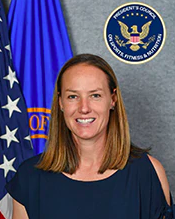By: Shauna Rohbock, PCSFN Council Member and Olympic Silver Medalist in Bobsled
February 5, 2020 marks the 34th anniversary of National Girls and Women in Sports Day. This year’s theme is “Lead Her Forward.” Annually, this observance celebrates the accomplishments of girls and women in sports, and provides us with the chance to highlight the importance of girls and women having equal access and opportunities to participate in sports.
One way we can lead girls forward and make sure they have the same opportunities as their male counterparts is through the National Youth Sports Strategy. The Department of Health and Human Services
developed this strategy in response to a Presidential Executive Order
calling for a national strategy to increase youth sports participation. The Strategy is built around a vision that, one day, all youth will have the opportunity, motivation, and access to play sports, regardless of their race, ethnicity, sex, ability, or ZIP code.
According to the Women’s Sports Foundation, boys get 1.13 million more sport opportunities than girls annually. Additionally, 40% of teen girls are not actively participating in sports. Growing up, I was lucky to have opportunities to play multiple sports, an opportunity that many girls never get. I grew up playing soccer and running track, and went on to play sports in college. As part of the Utah Army National Guard
, I became part of the U.S. Army World Class Athlete Program (WCAP)
, and also played professional soccer. I went on to compete at the 2006 Winter Olympics
in Torino, Italy, where I am proud to have earned a silver medal in Bobsled
. I also now coach bobsled for Team USA
. It is undeniable that my participation in sports shaped my life and career. The lessons I learned at an early age through sports helped me reach my full potential, and led me to where I am today as a member of the President’s Council on Sports, Fitness & Nutrition
, and an Olympic medalist and coach.
Many successful programs across the country are working to boost youth sports participation. The National Youth Sports Strategy highlights several of these “Bright Spots.” For example, Girls on the Run focuses on closing the participation gap for girls in grades 3 to 8 through physical activity-based, positive youth development programs. Learn more about their great work in this Bright Spot: Girls on the Run: Helping Girls Find Their Path
.
Everyone has a role to play in ensuring that our nation’s youth have access and opportunities to participate in sports and experience the associated benefits. So what can you do?
Parents
Children take their cues from you when it comes to being active and participating in sports. Your views on sports participation, and whether you are active yourself, will impact how your kids feel about being active and involved in sports. Here are some ways to keep your kids in the game:
- Make fun a primary focus of sports.
- Encourage sport sampling (playing more than one sport).
- Model good sporting behavior by interacting with other parents/caregivers, coaches, officials, and volunteers in a positive manner.
- Set a positive example by being active, participating in sports, or playing sports with youth.
- Sign up as a coach, official, or volunteer in a local youth sports program.
- Create environments that support unstructured sports play.
Coaches
You have a huge impact on how the youth under your charge view their experience with sports. Coaches have the ability to improve participation rates, health behaviors and outcomes, youth perceptions, and retention rates. You can also help reduce barriers to sports participation. Here are some ways you can positively impact participation:
- Emphasize skill development over competition and performance outcomes.
- Engage youth in the decision-making process.
- Adapt or modify sports activities and ensure access to equipment that meets the needs of youth of all abilities.
- Structure practices and games to provide all participants with more time engaged in moderate-to-vigorous physical activity to meet the Physical Activity Guidelines for Americans
.
Communities
The communities where our youth live and play can also have a critical impact on youth sports participation. The amount of resources dedicated to youth sports, and available spaces to play, will determine whether or not youth living within a community can participate. Here are some ways communities can ensure youth have the opportunity for sports involvement:
- Ensure safe play spaces are easily accessible for all youth.
- Promote the benefits of and access to sports opportunities to youth and their families.
- Promote and encourage partnerships across a variety of sectors, including business, community recreation, education, faith-based, government, health care, media, public health, sports, and technology.
- Develop shared use agreements to increase access to sports facilities at schools and within the community.
Learn more about the National Youth Sports Strategy and see other ways you can make a difference.
As we celebrate National Girls and Women in Sports Day, it’s important to spotlight the positive impact sports has in the lives of our nation’s girls and women. The early investment we make in keeping girls in the game will offer dividends through the skills they develop and lessons that make them strong, smart, and confident in all aspects of their lives as they grow into adults. I urge you to continue to find ways to support increased opportunities for the girls and women in your life to participate in sports. By doing this you will be investing in a brighter future for our nation through them.




